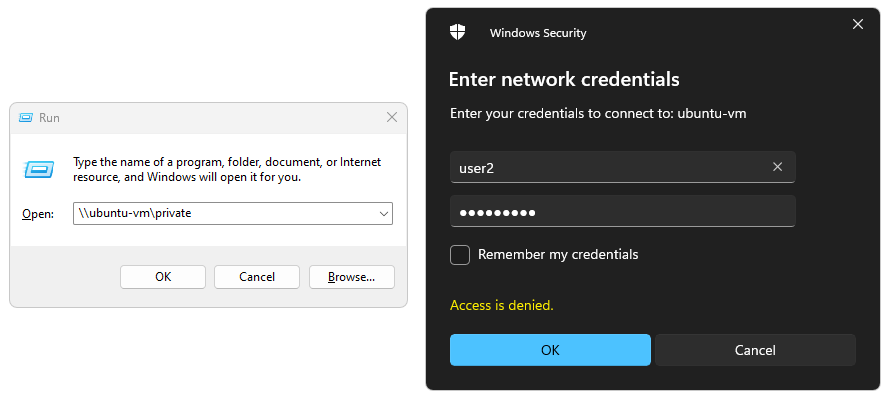Create a quick Samba file share server in Linux
Public + Protected folders
We will start this file server with two folders, each with their own unique function.
The "public" folder will be completely open to all and anyone on the network can read, add, remove, or modify it's contents
The "protected" folder will be visible to all but it's contents cannot be modified.
Installing Samba
Update packages
sudo apt-get update -y ✂
Install Samba
sudo apt install samba -y ✂
Open the firewall for Samba
sudo ufw allow samba ✂
Creating the folders, users and groups
Create folders
sudo mkdir -p /share/public ✂
sudo mkdir /share/protected ✂
Create smbgroup
sudo groupadd --system smbgroup ✂
Create smbuser
sudo useradd --system --no-create-home --group smbgroup -s /bin/false smbuser ✂
Make smbuser and smbgroup own the folders
sudo chown -R smbuser:smbgroup /share ✂
Give smbgroup write access to the folders
sudo chmod -R g+w /share ✂
Configuring Samba
Stop Samba
sudo systemctl stop smbd ✂
Edit the Samba configuration file
sudo mv /etc/samba/smb.conf /etc/samba/smb.conf.bak ✂
sudo nano /etc/samba/smb.conf ✂
Copy this configuration into the text editor and save
Start Samba
sudo systemctl start smbd ✂
Check if Samba is running
sudo systemctl status smbd ✂
View your hostname
hostname ✂
Connecting to Samba from a Windows client
Enable file sharing in Windows with Powershell
Enable-WindowsOptionalFeature -Online -FeatureName "SMB1Protocol" -All ✂
Set-NetFirewallRule -DisplayGroup "File And Printer Sharing" -Enabled True -Profile Any ✂
Connect to Samba from Windows
\\hostname
Private folder
The next folder on the file server will be private.
Hidden from public view and only accessible to "user2" with the right credentials.
Create folder and user
Create user for the system
sudo useradd -M -s /usr/sbin/nologin user2 ✂
Create private folder
sudo mkdir /private ✂
Give user2 permissions to folder
sudo chown -R user2:user2 /private ✂
Give user2 write access to the folder
sudo chmod -R g+w /private ✂
Configuring Samba
Stop Samba
sudo systemctl stop smbd ✂
Add user to Samba
sudo smbpasswd -a user2 ✂
Edit the Samba configuration file
sudo nano /etc/samba/smb.conf ✂
Append this to your smb.conf file and save
Start Samba
sudo systemctl start smbd ✂
Connecting to a private directory from Windows
\\hostname\private and enter user2's credentialsMoving Samba folders to a secondary drive
Generally, the drive with the operating system is not the main data store.
Let's move the Samba folders we made to secondary drives with large storage capacities.
Set permissions to parent folders
Say your drive is mounted at
/mnt/4TB and you want your folders to sit in /mnt/4TB/samba_folders,the folder
samba_folders and those leading up to it must have editing permissions for the owner and group and read permissions for all.
samba_folders to 775sudo chmod 775 /mnt ✂
sudo chmod 775 /mnt/4TB ✂
sudo chmod 775 /mnt/4TB/samba_folders ✂
Copy the folders to the new destination
The rsync command with "-avz" flags will
sudo rsync -avz /share/public /mnt/4TB/samba_folders ✂
sudo rsync -avz /share/protected /mnt/4TB/samba_folders ✂
sudo rsync -avz /private /mnt/4TB/samba_folders ✂
Give user2 permissions to folder
sudo chown -R user2:user2 /private ✂
Give user2 write access to the folder
sudo chmod -R g+w /private ✂


